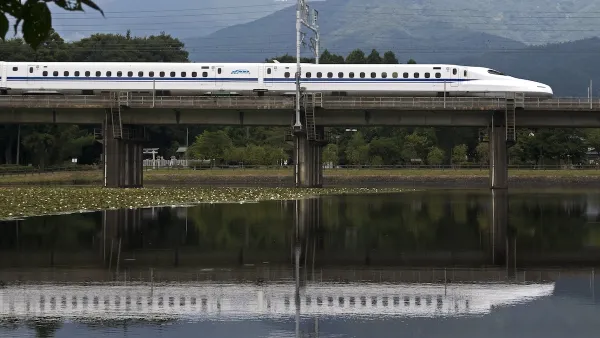Four years after a historic down payment was made on Pres. Obama's plan to connect 80 percent of Americans to fast trains, "the prospects for a national high-speed rail system seem bleak." Politics and funding challenges have derailed the plan.

For high-speed rail proponents, it's been four long years since the American Recovery and Reinvestment Act included a historic $8 billion down payment on the development of a nationwide network of high-speed rail. "Today," notes Yonah Freemakr, "while Amtrak ridership continues to increase, improvements to the rail system thus far have been too minor for most people to notice."
Freemark explains how the failure to find a dedicated funding source and the use of the topic as a wedge issue by Republicans have conspired to put the future of the federal high-speed rail program in doubt.
"Though the president mentioned high-speed rail in his State of the Union address this year, the transportation mode is absent from his new focus on urgent repairs of the nation’s infrastructure. Nationwide, the political winds suggest that there will likely be little significant progress over the next four years."
"Unless there is some unforeseen progress in convincing Republicans of the value of rail investments, federal spending on this transportation mode will be constrained for years," he concludes. "The Obama administration’s plan for a U.S. high-speed rail system, then, remains little more than a vision."
FULL STORY: Will They or Won’t They? The Romance Between Obama and High-Speed Rail

Maui's Vacation Rental Debate Turns Ugly
Verbal attacks, misinformation campaigns and fistfights plague a high-stakes debate to convert thousands of vacation rentals into long-term housing.

Planetizen Federal Action Tracker
A weekly monitor of how Trump’s orders and actions are impacting planners and planning in America.

In Urban Planning, AI Prompting Could be the New Design Thinking
Creativity has long been key to great urban design. What if we see AI as our new creative partner?

King County Supportive Housing Program Offers Hope for Unhoused Residents
The county is taking a ‘Housing First’ approach that prioritizes getting people into housing, then offering wraparound supportive services.

Researchers Use AI to Get Clearer Picture of US Housing
Analysts are using artificial intelligence to supercharge their research by allowing them to comb through data faster. Though these AI tools can be error prone, they save time and housing researchers are optimistic about the future.

Making Shared Micromobility More Inclusive
Cities and shared mobility system operators can do more to include people with disabilities in planning and operations, per a new report.
Urban Design for Planners 1: Software Tools
This six-course series explores essential urban design concepts using open source software and equips planners with the tools they need to participate fully in the urban design process.
Planning for Universal Design
Learn the tools for implementing Universal Design in planning regulations.
planning NEXT
Appalachian Highlands Housing Partners
Mpact (founded as Rail~Volution)
City of Camden Redevelopment Agency
City of Astoria
City of Portland
City of Laramie



























